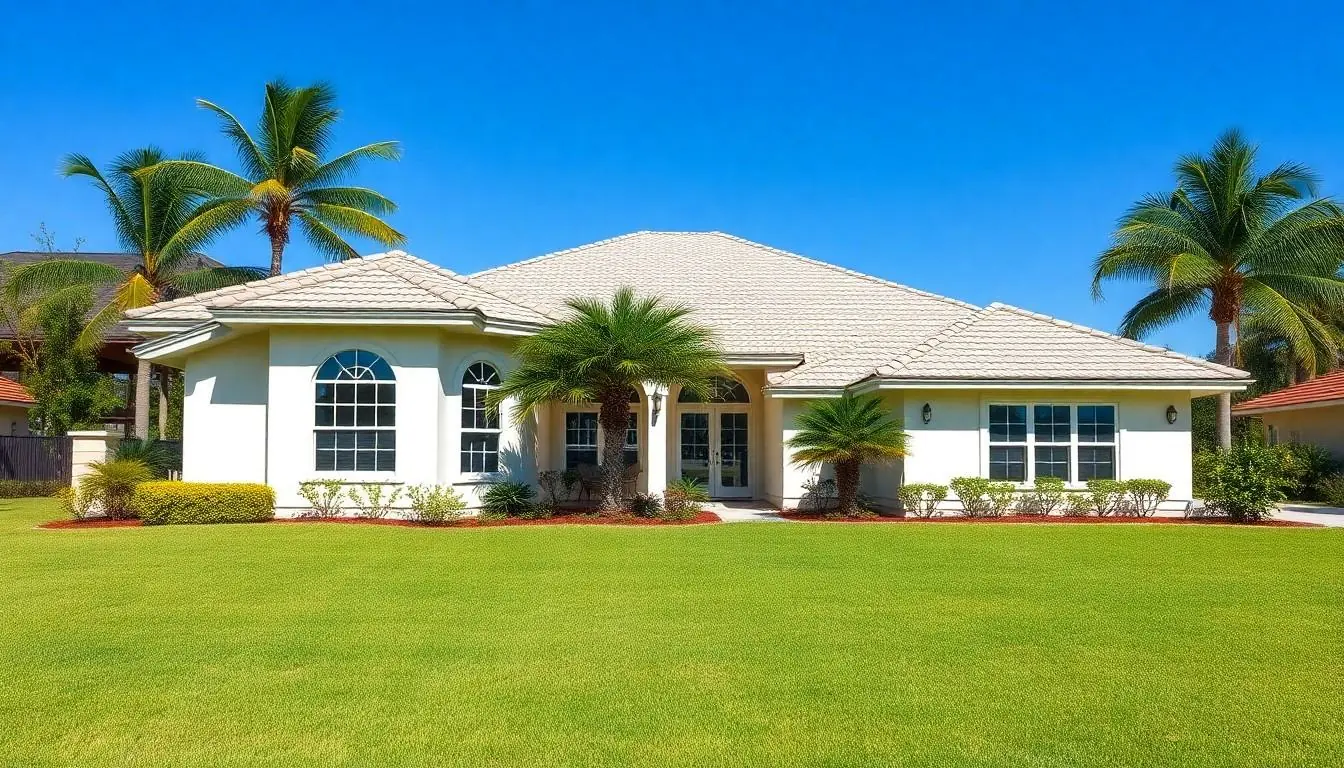In the Sunshine State, where palm trees sway and alligators might just be your neighbor, understanding Florida home insurance rates can feel like deciphering a secret code. With unpredictable weather and a penchant for hurricanes, homeowners often find themselves in a wild dance with insurance premiums. The good news? Navigating this financial maze doesn’t have to be a headache.
Table of Contents
ToggleOverview of Florida Home Insurance Rates
Florida home insurance rates reflect various factors, including weather risks and property values. Homeowners often encounter higher premiums compared to other states due to the likelihood of hurricanes and flooding. Costs average around $2,000 annually, with individual premiums varying significantly based on specific locations and home features.
The National Association of Insurance Commissioners highlights that Florida ranks among the highest states for home insurance rates. Factors affecting these rates include the condition of the property, its proximity to water, and the overall risk of natural disasters. Homeowners in coastal areas often face elevated costs due to increased storm surges and flooding potential.
Discounts may exist for home improvements that enhance safety, such as hurricane-proof windows or updated roofs. Insurance providers often consider claims history and credit scores, influencing rates significantly. Research indicates that maintaining a good credit score can lead to lower premiums, providing an incentive for homeowners to manage their finances carefully.
Annual policy reviews can help homeowners adjust coverage as needs change or rates fluctuate. Many insurance companies offer digital tools for comparing rates, making it easier to find competitive prices. Understanding the details of individual policies becomes essential, as some coverages may vary widely.
With the changing climate, it’s crucial for homeowners to stay informed about potential changes in policy rates. Awareness and proactive adjustments can help mitigate financial impacts. Regular consultations with insurance agents enable homeowners to obtain tailored coverage that fits their unique situations.
Factors Influencing Florida Home Insurance Rates

Various factors play a key role in determining home insurance rates in Florida. Understanding these elements helps homeowners navigate their insurance costs effectively.
Location and Risk Exposure
Location significantly impacts insurance premiums due to varying risk levels across the state. Residential areas near coastlines often face increased rates, attributed to storm surges and flooding risks. Urban regions may experience higher crime rates, increasing premiums further. Areas prone to wildfires or tornadoes also see upward pressure on costs. Insurers assess the likelihood of catastrophic events in each region, leading to tailored premium adjustments. Homeowners must consider these factors to make informed decisions regarding their policies.
Property Characteristics
Property characteristics are crucial when determining insurance costs. Features like the home’s age, construction materials, and overall condition influence premium rates. Older homes often require more extensive coverage to safeguard against potential damages, resulting in higher premiums. Additionally, homes built with storm-resistant materials may qualify for discounts, lowering costs. Roof type, electrical systems, and plumbing quality further sway insurance quotes. Buyers should prioritize property maintenance to ensure optimal rates.
Coverage Options
Coverage options greatly affect the overall insurance premium. Homeowners can choose between various policies, including basic, broad, or comprehensive coverage levels. Higher coverage limits provide increased protection but typically come with elevated premiums. Riders or additional endorsements can enhance coverage but also contribute to increased costs. Opting for a higher deductible may lower premiums but increases out-of-pocket expenses during claims. Homeowners must carefully evaluate their coverage choices to align protection with their financial situation.
Comparison of Florida Home Insurance Providers
Florida homeowners face numerous options when selecting home insurance. Various insurance companies offer distinct features, rates, and discounts.
Major Insurance Companies
Leading providers in Florida include State Farm, Allstate, and Florida Farm Bureau. Each company presents unique coverage options. State Farm is known for its robust customer service and comprehensive policies. Allstate offers numerous discounts, particularly for bundled services. Florida Farm Bureau typically caters to rural homeowners and provides more tailored coverage for agricultural properties.
Policy Features and Discounts
Homeowners should closely examine policy features from different insurers. Standard coverage often includes dwelling protection and personal property coverage, but variations exist among companies. Additionally, many insurers extend discounts for various safety improvements. Installing security systems or hurricane-resistant windows can significantly lower premiums. Maintaining a good credit score often results in better rates. Regularly reviewing policies ensures homeowners maximize benefit from available discounts and adjust coverage to current needs.
Trends in Florida Home Insurance Rates
Florida’s home insurance rates show significant variations driven by environmental and economic factors. Premium increases have become commonplace due to heightened hurricane activity and climate change.
Recent Changes and Predictions
Insurers raised rates by an average of 20% in 2022 as extreme weather events exacerbated claims. Many experts predict a continuation of this trend as more homeowners seek coverage against rising flood risks. Coastal properties, particularly those within 20 miles of the shore, face even steeper hikes due to storm surge potential. Increasing construction costs for repairs also contribute to the upward pressure on premiums. Data from the Florida Office of Insurance Regulation illustrates that nearly 40% of homeowners experienced rate adjustments in the past year. Moving forward, tighter regulations may emerge, which could stabilize or further elevate rates in various regions. Property owners thus need to stay informed about market dynamics to make educated decisions.
Tips for Reducing Florida Home Insurance Rates
Homeowners can take practical steps to lower their home insurance premiums. Implementing these strategies helps reduce overall costs significantly.
Bundling Policies
Bundling homeowners insurance with other policies, such as auto or renters insurance, often results in discounts from providers. Many insurance companies reward customers for consolidating their coverage. Choosing a single insurer for multiple policies simplifies management and can lower annual premiums by 10% to 25%. Additionally, bundling fosters loyalty, which may lead to further discounts over time.
Increasing Deductibles
Increasing deductibles represents another effective way to lower insurance rates. Homeowners can opt for higher deductibles, which often results in lower monthly premiums. For instance, raising the deductible from $500 to $1,000 could reduce costs by roughly 10% to 15%. Evaluating financial capacity to cover potential out-of-pocket expenses in the event of a claim proves essential when considering this option. Higher deductibles may provide savings for households that can budget for unexpected repairs.
Florida home insurance rates present unique challenges for homeowners. With the state’s susceptibility to extreme weather events and rising premiums, it’s crucial for property owners to stay proactive. Regular policy reviews and comparisons among different providers can ensure that coverage aligns with individual needs and financial situations.
By taking advantage of available discounts and implementing cost-saving strategies, homeowners can effectively manage their insurance expenses. As the market evolves, being informed about trends and potential regulatory changes will empower homeowners to make smart decisions regarding their coverage. Ultimately, understanding these dynamics can lead to better protection and peace of mind in a state known for its unpredictable climate.



